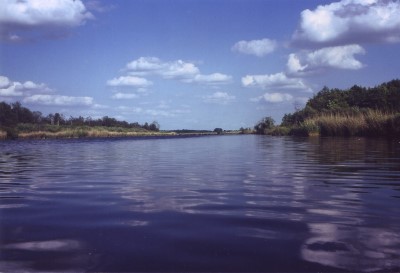
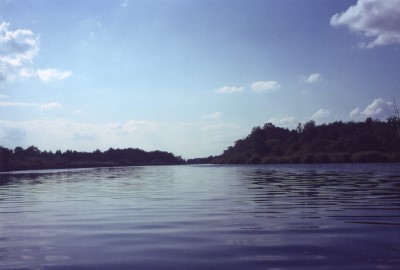
What a wonderful world
It was getting near Whitsun and
the
time to get the boats in water again, to wash the dust and dirt from
last year
off them – finally – and to start the new boating season.
As usual, we started to
look for somewhere to go. Again this year, the problem was not that we
could
not think of anywhere to go – but that there were far too many places.
We agreed on the Mecklenburg lake region, but first we wanted to get more information on the area. However, research in the Internet and in various forums showed that, at Whitsun, there was a genuine danger that one wouldn’t see the water for boats! As the Müritz was not one of the ‘larger lakes’ in any case, we decided to find another place in Mecklenburg. For us, this part of Germany was still an unknown land. ‘Terra incognita’ on the north-east edge of Germany.


We
decided in
favour of the River Peene. This river is also known as the ‘German
Amazon’. In
our opinion, this was a rather bold remark as Annette refuses to go on
the
‘genuine’ Amazon in the canoes with me – because of the snakes and
other
‘horrible’ creatures. We agreed on this although we also found reports
on the
Internet which also mentioned snakes in the area. However, in the
reports,
there was more mention of beavers than of snakes. These are one of the
animals
which we would really like to see from the kayaks. Our tour was to
start at Dahmen
on Lake Malchin. On the way to the Peene, we wanted to make a stop at
Wittenberg. In addition to Luther’s town, we also wanted to see the
school
there, which was designed by Friedensreich Hundertwasser. Getting there
proved
not exactly simple. By making an early start, we avoided the traffic
jams in
the area around Stuttgart. But then we got caught in the evening rush
hour
traffic in East Germany. It was almost 8 pm. when we arrived at the
youth
hostel in Wittenberg Castle. After getting settled in our room, we
started out
on our first walk round the town. However, that evening, our walk ended
in the
first pub that appealed to us.
On Saturday
morning, we could then
take another look at the town, by daylight. A really beautiful old
town. When
one actually sees the Hundertwasser School, it looks much more
attractive than
it does in art magazines. We wonder whether, on an average, students at
this
school get as high marks as those at ‘conventional’ schools.
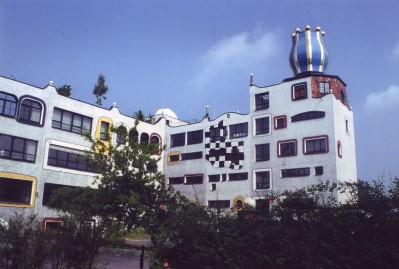
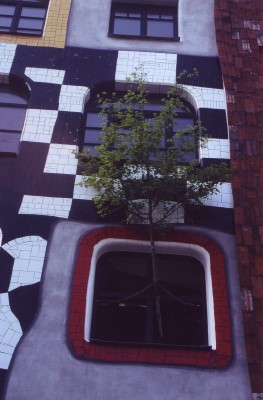
We particularly liked the idea
of ‘tree
tenants’ – where nature is literally rooted in human habitation and, at
the
same time, forms a connection between this and the light outside. Can
there be
anywhere better than such a school to show ecological connections.
In the afternoon, we had
difficulty
in reaching our actual destination, the camping ground, in Dahmen on
Lake
Malchin. For some reason, our route planner tried to direct us to a
place with
the same name but on another lake. Although we went a long way off our route, we finally reached the
camping
ground. After the long drive, Annette was genuinely tired and laid down
as soon
as we had set up the tent. While she was asleep, I put together our two
folding
kayaks.
On Sunday, we started on our
way.
First, we crossed Lake Malchin – which was rather rough for such a
small lake.
On arrival at the other end of the lake, the question was to find where
one
left the lake. Luckily, several canoes were coming from the opposite
direction,
so we quickly found the entrance to the Peene Canal, behind a wall of
reeds.
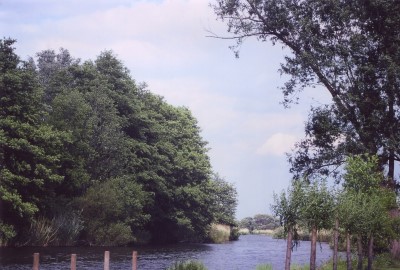
We brought the day to a close in
the
grounds of the Malchin Canoe Club, where we could erect our tent, after
paying
a low fee. Later that evening, the thunderstorm – which had been
threatening us
for half the day – decided to break.
Actually, we had wanted to go
on,
across Lake Kummerow, the next day - but everyone warned us of the
short, high
waves on the lake, which had already proved fatal to a few boaters. We
decided
to heed the warning and stay in Malchin for an extra day.
On our short, Sunday-afternoon,
boat
trip to the moor-land farmers, we saw a kingfisher. This café, which is
open
only in summer, can be reached only by boat or by a small track through
the
belt of reeds. While we were sitting there, four eagles flew up into
the sky,
from the opposite bank. The farmer’s laconic comment: ‘You leave my
hens
alone’.
The next morning, when we passed
the
moor-land farmer’s place on our way to Lake Kummerow, there was a
notice:
‘Eaten out of house and home – closed today’.
That sounds like a successful business!
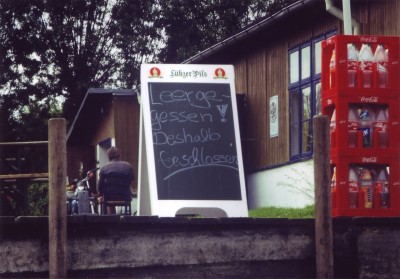
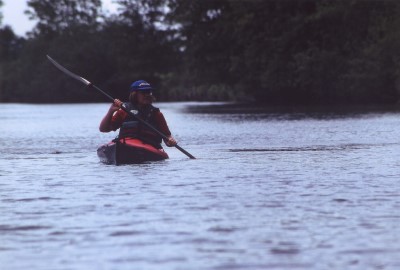
By the way, we
are in the process of
eating the river empty. At the café yesterday, we had trout; today we
are
eating wells, and in Dahmen we had pike-perch.
I had thought
that birds sleep at
night. However, that night, some of them did not keep to this rule. In
addition, there was a full-scale frog concert but, in spite of this, we
did
manage to get some sleep. Our trip continued along the Peene in the
direction
of Demin. This former Hanseatic town disappointed us – architecturally,
gastronomically, and in other ways. The next rest area for boaters was
Alt
Plestin. On the way, I startled an eagle. It rose up in the air,
protesting.
Presumably, I was just as startled as it was.
While looking
around Alt and Neu
Plestin, a man (about 70 years of age) tried to explain the situation
in the
village and the entire area. The reason he tried to do this was because
we were
standing in front of a farm, where emus were bred. What had actually
attracted
our attention was a stork’s nest with two baby birds. Nevertheless,
talking
with the pensioner was a real history lesson for us ‘Westerners’.
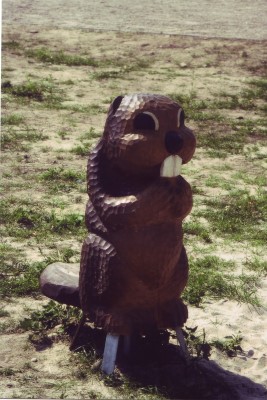
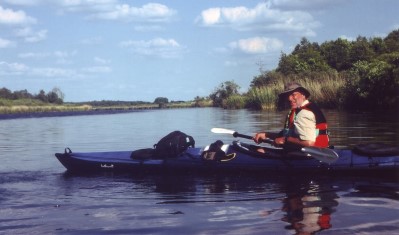
The river here
is already quite
wide. We have been sitting on the bank for some time, and it looks as
if the
river flows backwards. We had hoped to see beavers or otters this
evening – but
now it is after dusk, and not one has appeared.
This time, we
will only get as far
as Anklam. Usedom will have to wait until next time.
The next time
is two years later,
again at Whitsun. This time, on our way to the Peene, we decided to
take a
break in Dessau – to look at the master works of the ‘Bauhaus’
architects.
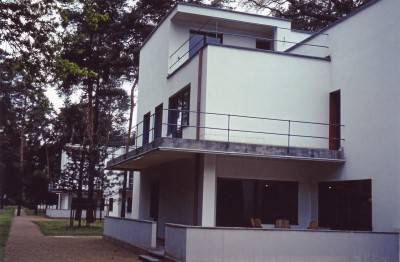
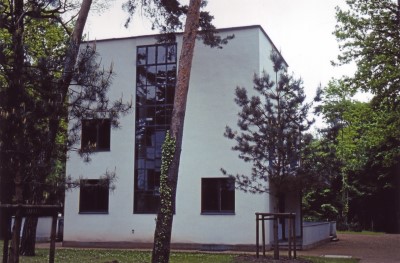
This time, we
wanted to start our
river tour on the beautiful rest place in Stolpe. But this time, I had
to put
the boats together in pouring rain. It was still raining the next day,
so we
took a trip to Anklam. In the afternoon, the rain gradually
stopped. On the way back – in the
dusk, we heard the slap of beavers’ tails on the water. We could see
them, but
it was too dark to take photos. We must have seen 15 beavers on our ten
kilometre return trip. My favourite was a beaver who was busy towing a
small
birch tree. For a long time, he wondered whether he really should dive
under
the water – in the end, he decided not to trust me. Because of the
beavers, we
missed our evening meal. – by the time we got back, it was too late. We
made up
for it the next morning – when looking round the harbour, we had
ordered
breakfast. And this morning, the table was set in the middle of the
harbour –
with a tablecloth, flowers, cake, fresh rolls and really good coffee.
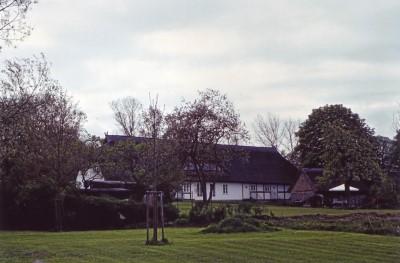
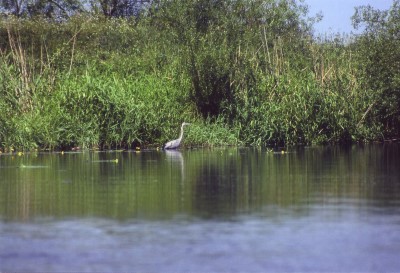
Back on the
river, we decided to make
a stop in Anklam on the way to Lassan. Anklam hadn’t changed very much
since
our first visit two years ago. The prime of Otto Lilienthal’s (German
aviation
pioneer) town seems to be long past – if it had ever had a prime.
From Anklam, we went on to the mouth of the Peene and the Achterwasser .
Until its
mouth, the Peene meandered
along quietly. After that, it became rather choppy. Not proper waves,
only a
restless swell. On the way, opposite Usedom, we found a place where we
could
land and stretch our legs. After that, we still had 10 km to go.
Sometime on
our way, the wind – which was coming from
straight in front of us – became much stronger. The waves became
higher, and
paddling became hard work. At last, the Lassam church tower appeared.
The landing
place had obviously not been used for a long time. Duck droppings
everywhere.
Presumably, the ‘nature camping place’ was given its name because –
apart from
mowing the grass – very little had been done there.
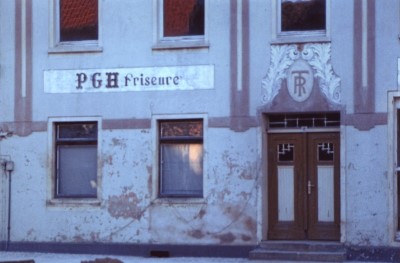
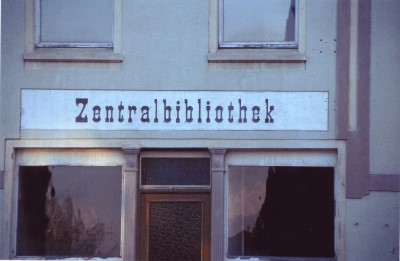
When we loaded the boots the next morning, a frog was sitting on a blade of grass and watching, with interest, what we were doing. It didn’t even move when we got into the boats.
Our
destination today was
Wolgast. Compared
with yesterday
evening, the water was smooth today – like a duck pond. However, this
gave us
the feeling that we were making no progress forward. The Peene Shipyard
in
Wolgast now belongs to the Hegemann Group, with its seat in Bremen.
Going past
this shipyard in a kayak was a great experience. Then at last, we
reached the Wolgast
bridge. Directly after this are the grounds of the Wolgast canoe club,
where we
could pitch our tent.
The next morning – after we had packed everything, packed the boats and launched them - as soon as we got into the wind, we saw that this would be a most uncomfortable day, with lots of hard work. For this reason, we decided to land in the next bay. Annette wanted to go off and fetch the car. However, we found that this bay couldn’t be reached by car. We had to carry the boats and all our equipment to the nearest parking area. As the way there went through an area with (kind of) allotment gardens, two folding boats being carried attracted notice. We completed the two kilometre way to the parking are amid teasing from the gardeners as to why our boats weren’t in the water. And then we had to repeat the performance with the second boot and the rest of our gear.
After we had
stowed the boats in the
car, we drove off to find the camping place that we had originally
wanted to
reach by boat - the
Forest Camp in
Freest.
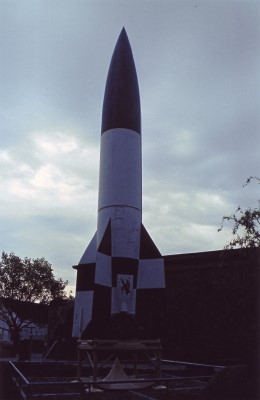
After a
leisurely shower this
morning, we made our way to Peenemünde. My first impression of the
museum was
very disappointing. There was only various kinds of ‘military scrap’ –
aircraft, helicopters, and missiles. But inside the buildings of the
former
power plant, it was much better. In my opinion, it gave the strong
impression
that those who worked here of their own free will were completely
unconcerned
about morals or ethics.
After that, we
carried on to
Heringsdorf and Ahlbeck. We managed to get a room in the youth hostel
in
Heringsdorf. Somewhere in Heinrich Mann’s book ‘Man of Straw’, there is a
scene which takes place on the island of Usedom. In our
travel diary, we
have written ‘Read it again’ – but I still haven’t done this. Many of
the old
villas have been restored beautifully and now contain holiday
apartments. But
we doubt whether they can all be let during the main
holiday period.
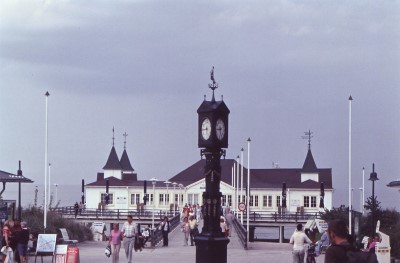
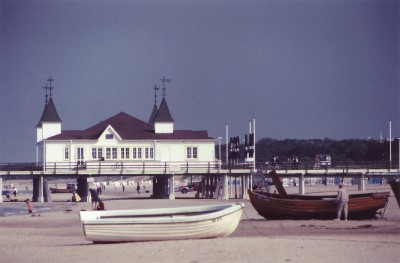
Thus ends our
river tour, in the
royal health resorts on Usedom – in not quite the right
style. The Greifswalder Bodden (bay) and the way to Rügen are
possible future places for us to go in this (for us) little-known part
of
Germany. The beautiful scenery and the friendliness of the people has
made an
impression on us.